Creator's
Prayer Song
(Northern Cheyenne)
322Kb MP3 (monophonic)
2 minutes 44 seconds
Labyrinth
Concepts and Random Thoughts:
A Brief Primer of Sacred Objects Found at the Labyrinth
We
could drone on and on about the physical characteristics of the
Labyrinth, but, as the saying goes “a picture explains a thousand
words,” the same, but more so, applies to the heartfelt objects
visitors surrender to the cairn. In the previous webspace pages you
have seen a sampling of just a few of these simple
treasures. Yet these objects speak volumes about the visitors, as
well as their uses of the Labyrinth. Some objects are left there for
others to take, while others are obviously left there in ritual.
We
will attempt here to identify just some of these objects and delve into
those that have a history, or tradition, in the spirit world. The
objects and tools used in ritual space are more symbolic than magical
in their own right. But the function they perform is undeniably
important.
Ancient
Egyptians believed in the power of amulets and other charms to protect
themselves from evil and to bring them good fortune. Evil forces were
believed to be everywhere and special amulets and ceremonies were
required to change one's fortune. Although
there are many varieties of spiritual observances performed today, the
basic ritual tools remain the same.
Ritual
tools are not absolutely necessary at the Labyrinth, though many people
find them helpful as tangible symbols of the process. A
ritual tool should be recognized only as a symbol of power used to
evoke an appropriate setting and should not be treated with fear.
Always remember that rituals at the Labyrinth are more symbolic than
magical.
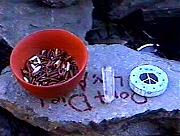

Akaba Talisman:
(also known as Akuaba or Akapa) Akaba Talismans are a powerful form of
folklore used by the Ashanti people who live in what is generally
Ghana. Akaba dolls are played with by little girls to teach them how to
take care of children, but the talisman, whose proportions are
considered beautiful, is primarily seen as a tool to increase fertility
in the childless and to ensure a beautiful healthy baby by the
pregnant.
Artificial Intelligence:
Hands down, artificial intelligence will prove to be man’s greatest
achievement. Forget man’s inevitable mastery of the atom, and
colonizing the distant planets. And our arts (a human manifestation)
are not likely to be understood by alien civilizations. It’s artificial
intelligence that will sweep across the universe.
There
will be no intellectual clash between the two, since, after a certain
level, communication between man and artificial intelligence will be
pointless. It will probably begin to manifest itself as man begins to
send intelligent space probes to the nearby stars, where
communications, even at the speed of light, will necessitate autonomous
decisions and actions on the part of the probe. Of course, man
will have to co-exist and learn to deal with the presence of a superior
being, but so will outmoded forms of artificial intelligence.
In
the past, man has actually embraced the presence of superior beings:
gods. The downside is that, at the time, man felt that his own
accomplishments were unimportant, and that worship and the afterlife
was where it was truly at. The flop (or uneventful passing) of the
Christian First Millennium radically changed western man’s outlook on
the world, that dramatically switched emphasis to a “can do” attitude
and set the stage for the Renaissance (which we’re still in, by the
way). Our descendants will somehow have to define and develop a culture
that will give meaning and purpose to their lives.
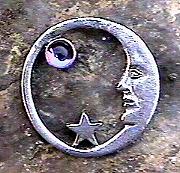
Astrology:
Ancient astronomy. (Greek astron “star”; legein “speak”) Astrology is
thought to foretell the future by studying the influence of the
relative positions of the moon, sun, and stars on human affairs. The
astrologer casts a horoscope based on the time and place of the
subjects birth. Western astrology is based in the 12 signs of the
zodiac; Chinese astrology is based on a 60-year cycle and lunar
calendar.
An
archaic science, a strongly held belief in ancient Babylon, astrology
spread to the Mediterranean world and was widely used by the Greeks and
the Romans. In Europe during the Middle Ages it had a powerful
influence, since kings and other public figures had their own
astrologers.
The
once-held assumption that Earth was the center of the universe was
crucial in serious interpretations of astrological readings. This
belief was supposed shattered by the Copernican revolution in the 16th
century, yet astrology later experienced a deathbed renaissance and is
now widely enjoyed as a popular, though admittedly superstitious
pastime. Whether professing belief in astrology or not, almost everyone
in the western world knows his or her astrological sign.
“It
is not in the stars to hold our destiny, but in ourselves.”
–William Shakespeare
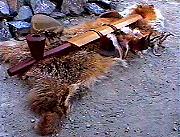
Ceremonial Burning of Tobacco:
Before smoking a ceremonial pipe, the American Indian would toss a
token amount into the fire, so that the fragrant smoke would rise up
into the heavens and appease to spirits of deceased friends and family.
Ceremonial
Smoking of Tobacco:
After tossing a token amount of tobacco into the fire, the American
Indian would light his calumet (ceremonial pipe), take a puff, then,
still holding it with both hands, pass it to the person on his left.
The pipe would continue around the circle until the last person had
smoked. The pipe would then be respectfully passed back, to the right,
completely around the circle, for the host to tamp, re-light, and
repeat the process, again to the left. Any tobacco ashes cleaned from
the pipe would be carefully deposited onto a flat stone beside the fire
pit.
The
American Indian also enjoyed casual smoking with his personal pipe and,
the much later, pipe-tomahawk (a European invention). Sitting in
a circle, or in small groups, each person usually had his own pipe, and
the setting was completely light-hearted and informal.
Ceremonial
Tobacco Track:
A tobacco track laid out across the path at the Labyrinth imparts good
will to all who cross it. Grown and traded by the American Indians of
the east, southeast and northeast, tobacco was typically planted and
cultivated using implements fashioned from the branches of a tree that
had been struck by lightening. While divine, this just simply made it
kosher.
After
harvesting and curing, special spiritual properties were then bestowed
upon the tobacco, by virtually anyone, with simple rituals that varied
greatly, depending on locality. In one such ritual, one would stand on
a hilltop, or by a river, at sunrise. Tightly twisting the tobacco
leaf, clockwise, the proper chants were recited. The blessed skein of
tobacco was then cut into small pieces and scattered across targeted
paths of foot traffic.
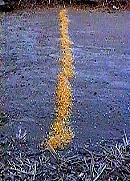
Corn Meal Track:
At the Labyrinth, its presence simply alerts visitors to observe common
courtesy if others are in meditation or ritual at the central cairn. If
no one is present at the center, feel free to pass through. It’s quite
common to be waved in by those at the center.
Historically
practiced by the Indians of the American southwest, in time of ritual.
The village shaman would sprinkle a track of corn meal across any and
all trails leading to the village on the mesa as a signal to outsiders
that passage was forbidden for the duration of the ritual, sometimes
running into days.
Crystals:
Many types of stones are thought to protect against misfortune, but
special metaphysical properties are credited with those that interact
with light. Crystals are intuitively the stone of choice in preparing
ritual space and are compatible with a full spectrum of religious
faiths and spiritual beliefs. It is believed that crystals have the
ability to connect to spirits, spirit guides, spiritual energy and help
with channeling spirits and increase cosmic awareness.
Some
credit crystals for their spiritual awakening. Modern day psychologists
agree that the subconscious controls every word, deed and action in our
conscious lives. Crystals work psychologically on the subconscious as a
constant reminder of what you desire to achieve and strengthens the
power of positive thinking.
Crystals
have a rich history in mythology, legends and folklore. Egyptian,
Greek, Roman, Celtic, Native American, Australian Aborigines, ancient
Chinese and ancient Japanese cultures all included crystals in at least
some of their spiritual rituals.
Especially
valued are clear quartz crystals. Quartz (silicon dioxide) is one of
the most abundant minerals in the world. Sand is mostly comprised of
quartz. Even the trace amounts of dust in the air we breathe is high in
quartz content. And quartz crystals really do vibrate. Quartz is both
piezoelectric and pyroelectric.
Clear
quartz cleans the aura, contains great healing energy, and has very
strong powers of protection. Clear quartz crystal is the universal
stone, excellent for meditation and bringing harmony to the soul. It
corresponds to all zodiac signs. Many are drawn to clear quartz
crystals as the ultimate symbol of purity, a representative of
perfection.
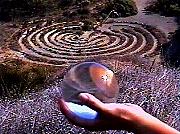
Crystal
Ball:
Crystal gazing or scrying the future within a crystal ball was a
popular pastime in the Victorian era and has remained popular through
to today. Scrying with crystal balls can involve elaborate rituals for
cleaning the crystal ball or you can simply cleanse it with salt water
bathed in the sun and moon, in a stream with running water or with
incense. Crystal balls are excellent for conducting crystal-gazing
sessions, which are said to work best when the Sun is at its
northernmost declination. Immediately before the appearance of a vision
(which may be realistic or a mere wispy swirl), the globe is said to
mist up from within.
Death:
Our only true connection with the afterlife may be that of ritual
space: the honoring and remembrance of the departed, those who were
close to us when they were alive.
We
are all familiar with stories of near-death experiences: the long dark
tunnel into a surreal world of light, being warmly greeted by deceased
loved ones, and a reluctance to return. Yet, those who have come back
and described these events did not experience death, but simply an
initial phase of the medical dying process. This recent phenomenon
appears to be more of a testimony to the miracles of modern medicine
and not a timeless spiritual experience that is suddenly being brought
out into the open and embraced by the public. Yet it is very likely
that near-death experiences, in ancient times, may have been the basis
for our present beliefs in the soul and the afterlife. Today, a
substantial number of those who have come back from a near-death
experience have embraced a spiritual outlook on life and have taken on
a new direction, a mission in their earthly realm.
Yet,
there is one intriguing feature in almost all of the differing accounts
of heaven. It really makes no difference whether heaven promises to be
a harem of beautiful maidens, or a bright, light-hearted, airy world of
clouds, with singing angels and deceased loved ones, or simply an
unbelievably prosperous extension of one’s present life. The attribute
that is common throughout all of the written accounts of heaven is that
heaven is, surprisingly, earthlike. Our forefathers, in easing our
inevitable meeting with the grim reaper, may have felt that we would
fear an afterlife that differed dramatically from the present.
Another
thought, and an uncomfortable one, is that most concepts of heaven
appear to have been shrewdly devised to de-value our earthly existence.
One must remember that, in pre-literate society, a blessed few received
a formal education and enjoyed a truly enlightened existence.
Certainly, popular folklore celebrating the underdog abounds: that
Christopher Columbus had a theory that our world was spherical in shape
and was determined to put his theory to a bold and dangerous test.
But
the fact of the matter is that all privileged, educated people at the
time knew that the earth was round and they believed it to be a perfect
sphere, with a circumference of 24,867 miles (very close!). And they
did not correct Columbus when he declared that his own calculations
determined the world was about 15,000 miles in circumference, putting
the orient well within reach. You see, at the time, accurate and
truthful information was for the privileged only. The afterlife was
preached to the masses while the privileged class was preoccupied with
the here and now. And Columbus was allowed to set out on his adventure,
which was, at the time, believed to be far more hazardous than he could
ever have imagined.
Just,
maybe, the concept of heaven is a veiled word to the wise. Man did
evolve on Earth. We function at our best on terra firma –more than
anywhere else. And we are superbly equipped to breathe, experience joy,
run, hunt, love, wage war, yet practice surprising acts of charity.
Life, more so than the afterlife, freely offers us the paths of good or
evil, a pure, idyllic existence where virtue is its own reward. And
that is the true spirit and essence of us all. Life, liberty, and the
pursuit of happiness. Take away any part of that formula and the human
spirit will truly cease to exist. Even in the afterlife. The veiled
word to the wise is to treat every day on this brilliant blue jewel in
the universe as a unique event. Our visit here is a very special gift,
and one that is all too temporary.
"I
can't help letting my mind wander to the implications of Alzheimer's
disease for the theory of an immortal soul." -- Barbara
Ehrenreich

Gaia Hypothesis:
The theory that the Earth’s living and nonliving systems form an
inseparable whole that is regulated and kept adapted for life by living
organisms themselves. Named after Gaia, in Greek mythology, the goddess
of the Earth, the Gaia Hypothesis holds that since life and environment
are so closely linked, there is a need for humans to understand and
maintain the physical environment and living things around them.
One
might convincingly argue that Man is Gaia’s most recent trump card in
the game for survival. We are now witnessing Earth’s sixth mass
extinction and it's the human race causing the extinctions of 50,000
species of both animal and plant life a year. Yet, in spite our man’s
wide-spread ravaging and damage to the Earth and its ecosystem, the
Earth’s salvation may be our unique ability to prevent mass extinctions
by diverting asteroids that are on a collision course with Earth. Even
the far-fetched vision of regulating the brightness and intensity of
the Sun, are daunting challenges that are well within the domain of
man’s intellect.
But,
as David Attenborough, writer and presenter on BBC's Ascent of Man
reminds us: Don’t kid yourself. Our great works, our incredible
engineering feats, our highways, our skyscrapers, our cities are, in
the scheme of things, just as natural as a mole hill or a beaver dam.
And no matter what Man does to the Earth, no matter how much we ravage
and plunder the Earth, the Earth’s ecosystem will quickly make the
appropriate changes and bring the environment into perfect equilibrium
and harmony. It can’t be any other way. You see, the Earth is a totally
closed ecosystem. The real question is will Man find the new order
acceptable.
“This
world is a vast unbroken totality, a deep solidarity joins its contrary
powers.”
–Sri
Aurobindo
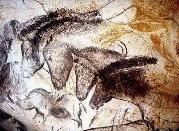
The Great Flood:
An actual event that occurred at the end of the last ice age, when the
both the Mediterranean and the Black Sea were vast valleys, below sea
level. The worldwide melting of the continental glaciers caused a 400
to 450 foot rise of the world’s oceans, triggering a massive salt water
cataract at what is now the Straight of Gibraltar.
The
indigenous tribes inhabiting the low lying plains most likely simply
gathered their belongings and fled on foot, along with the local fauna,
in a casual, but unending retreat into the distant highlands. The
flooding of the plains created a profound change in the local weather
patterns, causing ample rainfall conditions where there was previously
a developing semiarid environment, creating the illusion that the flood
came from the heavens above.
The
unfortunate few, those who retreated to local hill tops for refuge,
were inevitably forced to build makeshift crafts to save their people
and livestock, where hard choices were made as to who was evacuated and
who was left behind.
Folklore
of the Great Flood was passed down in oral tradition through the
generations, with the inevitable embellishments that we’re all familiar
with. The seemingly unlikely similarities of the epic tale among
dissimilar cultures in the region prompted scientists to investigate
the possibility of such a flood, formulating the very preliminary
scenario described above. The next logical step is the daunting task of
underwater archeological research.
No
doubt, some nations in the area will discover their roots in some of
the yet undiscovered, submerged sites. Although it is assumed that the
prehistoric tribes that inhabited the basins were pre-literate, it is a
tantalizing thought that a hieroglyphic stone or terracotta equivalent
of the Dead Sea Scrolls may be discovered, abandoned at a time when our
ancestors had to travel light.
Stay
posted.
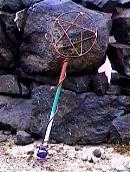
Magic Wand:
The wand is a wooden stick, carved from one of the traditionally
considered "sacred" woods, such as holly, yew, maple, mahogany, and
used to channel power. It usually is powerfully enchanted with a
magical element embedded in its core, such as a dragon’s heartstring, a
hair from the mane of a unicorn, a phoenix talon or feather, silver
thistle, bog myrtle, wood rose, etc. The wand is often decorated and
carved in accordance with the spell caster's beliefs. The wand is an
extension of the wizard or sorcerer’s mind and arm, giving direction
and control to their powers.
If
you have coveted and taken a wand left at the Labyrinth, beware. The
wand may appear to do nothing. But any incantation used in ritual with
the wand will produce some results, in some form, somewhere. And only
an inexperienced fool casts spells about, carelessly, everywhere. Some
of the greatest woes on earth are the result of a thief’s inability to
control their stolen wand.

Music of the Spheres:
The mysterious phrase “the music of the spheres” has intrigued and
haunted Western thinking for over two thousand years. All energies have
a frequency of vibration. Humans hear, see, and feel only a very
limited band width of these universal energies. Pythagoras, the ancient
Greek mathematician and philosopher, called the band widths which a
human being could not see or hear "the music of the spheres."
The
ancient Greeks believed that “the Music of the Spheres” was a perfectly
harmonious music, inaudible on the earth, thought by Pythagoras and
later classical and medieval philosophers to be produced by the
movement of celestial bodies. This celestial music is commonly thought
to be the ‘music’ of the movements of the planets of our solar system.
The
ancient Pythagoreans believed that our familiar earthly music was no
more than a faint echo of the universal 'music of the spheres'. Not
surprisingly, no one has actually heard the music of the spheres. In
any case, some early astronomers accepted that the 'music of the
spheres' was a spiritual ideal, rather than a reality. Some suspect
that the fundamental meaning, the ancient vision, may have been
obscured by this primary focus on the outer world, an outer cosmology.
We
now know that planets passing through the vacuum of space are unlikely
to generate the abstract forms of music so sought after by the
ancients. But, just as a tuning fork has a natural frequency for sound,
the Earth, does in fact, has a natural, vibrating frequency. The
earth’s free oscillation, or “heartbeat,” pulses at a rate of between 2
to 7 millihertz. Alas, while our mortal ears are filled with this
background sound, we are unable to hear it, since sound waves below 20
cycles (hertz) per second are inaudible to humans.
With
all your senses, strive to listen to this music and, along your
personal journey into the mysteries of the human psyche, discover the
harmonies of your own inner world.
Ouija:
Pronounced as wee-ja or wee-gee, and is a form of seance in which a
central object is guided towards letters at the edge of a board.
Participants place a finger on the central object and ask questions of
an entity.
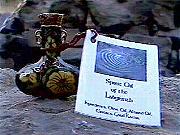
Spirit Oil of
the Labyrinth:
Not an uncommon feature of the Labyrinth, Spirit Oil of the Labyrinth
has, in keeping with the interfaith nature of the Labyrinth, been given
no special blessings, no rituals, and no special preparation
whatsoever. It is special in that it’s over 20 years old. A Friend of
the Labyrinth simply forgot and then rediscovered the unopened, 6 fluid
ounce bottle of the oil while cleaning up her cellar. And like a 20
year old bottle of wine, the most appropriate way to enjoy it, it
seemed, was to pass it around, to give others a chance to experience
it.
Actually
a massage oil, made from a simple combination of olive oil, almond oil,
and essential fragrance,
it
has been given the name (and a label) simply to inform visitors of what
it is. The tiny size of the bottle reflects the fact that it’s in
extremely short supply. As a lot of things at the Labyrinth, its use
and application is entirely dependent upon the visitor’s interpretation
and needs.
A
good start, however, would be to examine the historical use of Holy
Oil. Defined, Holy Oil, or more precisely, Holy Anointing Oil, is olive
oil and balsam, prepared with the utmost care and reverence in the Holy
Land (in Bethlehem, Israel, or on Mount Carmel, Israel), and then
blessed by a bishop. Holy Oil is used in prayer, in religious
celebrations, on newborns to ward off evil, for sacraments during time
of illness and hardship, or simply coveted as a spiritual keepsake. It
is clearly forbidden to be used in a common fashion.
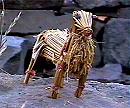
Spiritual Animal Effigies:
The American Indian would craft an effigy, or likeness of his intended
game in a simple ritual in preparation for the hunt. Such
visualizations and imagery were an essential part of early cultures in
their struggle for survival. Pictured is a straw Inca style alpaca
figurine (or effigy).
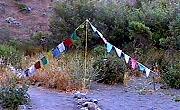
Tibetan Prayer Flags:
Traditional Tibetan Buddhist prayer flags are used throughout the
Himalayas, creating an atmosphere of peace, serenity, and hope. Tibetan
Prayer Flags are traditionally hung atop mountain summits, over
bridges, roof-tops, outside temples, at crossroads, holy sites, or
anywhere open to catch the wind and carry the prayers off. This is
thought to be beneficial for all. The prayer flags deteriorate from
time and are typically renewed each Tibetan New Year by pilgrims
visiting sacred sites. The old flags are not removed, and they
eventually build into wonderful displays of prayers and colors.
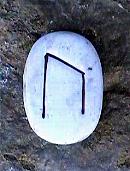
Viking
Runes:
The ancient practice of casting runes, in the act of divination, is
still an enjoyable pastime for many. Rune casting has a history going
back 2,000 years. The, much later, Viking runes were an essential part
of the Nordic way of life, with village shamans consulted regularly to
cast and interpret runes on important issues.
The
Viking runes typically consisted of a collection of small, flat stones
with a letter of the Viking alphabet (or rune) painted on one side, in
human blood. Shaken in a pouch, the stones were then scattered on the
ground. The oracle of the runes would then begin.
Unfortunately,
no one today truthfully knows the ancient interpretation of a random
cast of the Viking runes. Although rune casting by Germanic tribes was
written about by Tacitus, the Roman historian, he was not privy to
their secrets. The last masters (both men and women) of Viking rune
casting died out in seventeenth century Iceland and with them died the
secret oracle of the runes. The avid belief in rune casting seems to be
a feature of pre-literate society.
But
don’t be quick to make light of those who practice Viking rune casting
today. We could assume that the secret of the runes was so valuable a
commodity in ancient times that it was almost never passed on, and
usually had to be re-invented by the next generation. Those were the
times before FDR’s “New Deal” and everyone had to struggle up until
their death to make ends meet. This idea is not too far-fetched.
Remember the Stradivarius?
Never
underestimate the wily, astute soothsayer who can quickly assess the
personality, character and background of their client, intently listen
to their specific quest, and then de-code what they are told and
succinctly distill it down to its essence: the very private, yet true
desires of that person. Instead of a direct response, the soothsayer
will always carefully craft an answer in the form of a cryptic, yet
telling, oracle. Runes, tarot cards, crystal ball, all these props,
these materials are really, in the end, immaterial.
Runes
(also called runestones) are the most ancient of the Germanic peoples'
magical written symbols. If not offering us deep insights into the
hidden structures of the cosmos, then certainly exposing the secrets if
the human psyche. The runes are a method of communicating with
divinity—the god (or goddess) within each of us who embodies our pure
consciousness and inward spirituality.
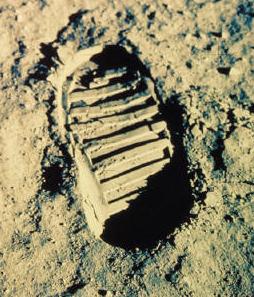
Vision Quest:
The solitary quest for a revelation in one’s life, to seek out their
guardian spirit and give direction, to make them whole.
In
traditional American Indian culture, one would leave their village and
make a solitary trek into the wilderness, to listen to the voices of
the spirits and find their path in life. A person on such a vision
quest would spend 3 or 4 days fasting and sitting in deep meditation,
in a canyon, cave, on a mesa, on a mountain top, beside a river, or in
the desert, patiently waiting, and inviting the spirits to send a
revelation to them. Only in a depleted state could they be receptive to
the spirits. When they were fortunate enough to have experienced a
vision, they would return to their people, tired and hungry, but
clearly elated. Others would often be consulted, to help them determine
what they had experienced and offer suggestions as to how they were to
act on their divine message. Direct contact with the spirit would be
periodically maintained through later vision quests, throughout an
entire lifetime.
The
challenge for you is to discover how to evoke a similar experience in
your own contemporary culture.
Wicca:
A wizard or witch; A religious cult based on love, worshipping a
Goddess, and rituals of witchcraft. Most of the rituals involved in
Wicca is based on Celtic, Norse or Druid Magical practices. Wicca
utilizes certain "Astral" energies to magically transform ones life.
Wind
Chimes:
An adaptation of the communal wind bell of ancient Japan to ensure crop
fertility, the first wind chimes were made in the Victorian era simply
as a garden accessory. Wind chimes are now almost universally
considered essential to the spiritual and mystical experience.


|

